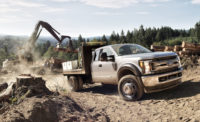In the world of work trucks, it’s not every day that a segment-leading model gets a complete makeover, but the all-new 2017 Ford Super Duty is the line’s first major change since 1999, the company says.
For its new Super Duty trucks—which include the F-250, F-350, F-450 and F-550 models that serve as go-anywhere construction haulers—Ford engineers tell ENR they have upgraded virtually every component, keeping in mind commercial users’ needs.
Not-So-Heavy Metal
Similar to the half-ton F-150, Super Duty switches from steel to aluminum for body panels and cargo boxes. Ford says the bed aluminum is 20% thicker than the F-150’s while backed up by larger cross members—all designed to stand up to rougher use that construction users are likely to experience.
All together, these changes are said to shave 350 lb off past curb weight while making the trucks stronger, such as allowing Ford to create larger, fully boxed frame rails and up to 10 similarly upsized cross members. Because these elements are made from 95% high-strength steel, the result is a frame that, For notes, is 24 times stiffer than the outgoing model’s.
On a recent drive in Colorado, we noticed a clever design detail: the hitch receiver that now extends farther into the frame. Ford says this makes it possible to tow the heaviest conventional trailers without the hassle of a traditional, weight-distributing hitch.
Power To Spare
Under the hood, the new Super Duty comes standard with a 6.2-liter gasoline V8 that has been tweaked to put out a respectable 385 horsepower and a class-leading 430 lb-ft of torque. However, the big news here is that the optional 6.7-liter Power Stroke turbodiesel V8’s output has been bumped up to an impressive 440 hp and 925 lb-ft of torque.
During the two-day test drive this summer, the gasoline V8 performed well enough to make it seem like an acceptable choice for many work-truck applications. The turbodiesel V8 is the more muscular of the two, offering power to spare, even when towing a 10,000-lb gooseneck trailer.
Both engines come mated to a six-speed automatic transmission. The truck’s familiar tow-haul mode adjusts the transmission’s shift points to suit the load and road conditions, while a three-position engine brake helps to keep speed in check on downhill stretches.
Crew-cab, long-bed models get a larger, 48-gallon fuel tank for greater range between fill-ups. Diesel-powered models also get 7.5-gallon diesel-exhaust-fluid tanks, complete with a gauge in the instrument cluster that makes it easier to keep tabs on a driver’s DEF levels.
On and Off the Road
One of the advantages of sharing body panels with the F-150 is a larger cab and interior on the Super Duty trucks. The new bodies are also said to be more aerodynamic, which, along with the truck’s weight loss, should help marginally boost fuel economy, Ford engineers say. The U.S. Environmental Protection Agency does not require manufacturers to post mileage estimates for trucks of this size.
On the road, the stiffer frame and hydraulic rear-body mounts help to improve both handling and ride quality. Steering feels more precise, lending a feel of confidence going down the road. Off the pavement, the steep slopes, bowling-ball-sized rocks and water-filled mud pits we tackled didn’t slow down our FX4 optioned, four-wheel-drive test model.
Towing Tech
The new Super Duty includes a mind-boggling array of new technology. For starters, available adaptive steering makes this big truck feel lighter on its feet. This setup also has a calibration that ties into the tow-haul mode for improved steering stability when towing.
Ford engineers also have developed features designed to simplify the trailering experience. For example, an available blind-zone monitoring system now extends its alert area to cover the length of the trailer. A fine-tuned trailer-sway control system helps to keep things in line in crosswinds and other challenging driving conditions. Another handy feature is a “trailer reverse guidance” system, which coaches drivers which way to turn the steering wheel to achieve the desired effect when backing up.
Another useful option is the seven-camera guidance system, four cameras of which give a top-down view of the truck when negotiating tight quarters. Among those cameras are a front-mounted unit, which makes pulling out of a street with limited visibility less stressful, and two rear cameras, which make single-handedly hooking up a trailer a snap. An optional eighth camera can be mounted on the rear of a trailer. The Super Duty also offers an adaptive cruise control that works even when trucks are towing heavy trailers.
Properly equipped, the F-250 now can tow conventional trailers up to 18,000 lb. The F-350 and F-450 can pull conventional trailers up to 21,000 lb and gooseneck trailers up to a 32,000 lb and 32,500 lb, respectively. Ford notes that towing capabilities are best in class for the 2017 Super Duty models, whose list prices start at $33,730.
Put it all together, and you have a trio of all-new Super Duty pickups that should be able to handle most anything your workday throws your way.






Post a comment to this article
Report Abusive Comment